
|
The first step in the process of investigation of drain and sewer systems is the review of their performance capacities based on given information. The review is done based on available incidence reports and analysis results that might provide an insight into possible performance impairments. It thus forms the basis for determining the scope of the inspection |
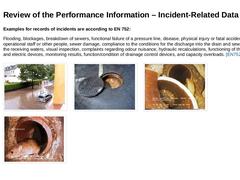
|
Examples for records of incidents are according to EN 752: Flooding, blockages, breakdown of sewers, functional failure of a pressure line, disease, physical injury or fatal accidents of the operational staff or other people, sewer damage, compliance to the conditions for the discharge into the drain and sewer system and the receiving waters, visual inspection, complaints regarding odour nuisance, hydraulic recalculations, functioning of the mechanical … |

|
For large drain and sewer systems, it can be useful to combine the evaluation of incidents with other operational, hydraulic, economic and strategic aspects, such as the relevance of the development (hospital, industrial plant, etc.). The result could be a priority ranking or area ranking for planning the investigation in the respective subcatchment areas. (Image: Example of an area ranking) |

|
In the second step of the investigation, the gathered results serve as a basis for the review of the information regarding the capacity and the determination of the scope of the investigation, i.e. whether and to what extent investigations will be necessary with respect to: -
structural,
-
environmentally relevant,
-
hydraulic and
-
operational
aspects, and which of the investigation methods that are subsequently explained are suitable … |

|
What is relevant informationen? (Image: Schritte) In the third step, all available relevant information of a drain and sewer system is collected and reviewed. This step provides the basis for the subsequent planning of all further activities. Relevant information here includes: 1. Inventory data, 2. Required permissions and statutory requirements, 3. Existing operational, maintenance-relevant, structural and safety-related measures for problem solving,… |
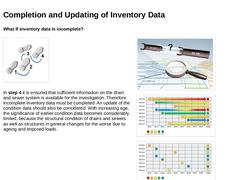
|
What if inventory data is incomplete? (Image: Schritte) In step 4 it is ensured that sufficient information on the drain and sewer system is available for the investigation. Therefore incomplete inventory data must be completed. An update of the condition data should also be considered. With increasing age, the significance of earlier condition data becomes considerably limited, because the structural condition of drains and sewers as well as structures … |

|
|
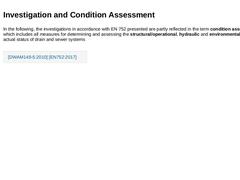
|
In the following, the investigations in accordance with EN 752 presented are partly reflected in the term condition assessment, which includes all measures for determining and assessing the structural/operational, hydraulic and environmentally relevant actual status of drain and sewer systems [DWAM149-5:2010] [EN752:2017] |

|
The 5th step, the structural investigation, is mainly used to determine damages or defects that influence the structural condition of the system. Apart from damage that has an impact on the structural condition of the system, the age and position of the existing infrastructure, the geotechnical data of the bedding zone and the surrounding subsoil, as well as the potential of damage that could put existing buildings and other supply … |
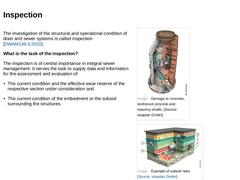
|
The investigation of the structural and operational condition of drain and sewer systems is called inspection [DWAM149-5:2010]. What is the task of the inspection? The inspection is of central importance in integral sewer management. It serves the task to supply data and information for the assessment and evaluation of: |
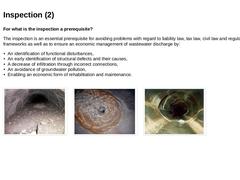
|
For what is the inspection a prerequisite? The inspection is an essential prerequisite for avoiding problems with regard to liability law, tax law, civil law and regulatory frameworks as well as to ensure an economic management of wastewater discharge by: -
An identification of functional disturbances,
-
An early identification of structural defects and their causes,
-
A decrease of infiltration through incorrect connections,
-
An avoidance of groundwater …
|

|
When does the inspection come into play? An inspection is carried out within the framework of: -
Scheduled inspections as a part of self-monitoring,
-
Inspection as a part of the final “acceptance of sewer”,
-
Inspection prior to the end of the statutory period of limitation for claims arising from any defects (warranty inspection),
-
Detection of operational disorders,
-
Preparation/execution of rehabilitation measures,
-
Execution of special tests and …
|
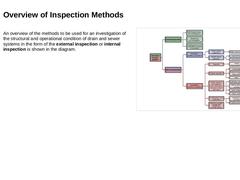
|
An overview of the methods to be used for an investigation of the structural and operational condition of drain and sewer systems in the form of the external inspection or internal inspection is shown in the diagram. (Image: Methods for structural investigations of drains and sewers (the methods of engineering measurements for application in accessible sewers are not shown)) |

|
|

|
Which measures count for external inspection? External inspection comprises all measures that are carried out either from the ground surface or specifically prepared explorations. The xternal inspection includes: -
Walk-over inspection of the pipe run
-
Geotechnical investigations
-
Investigation of buildings and subsoil through outcrop.
(Image: Methods for structural investigations of drains and sewers (the methods of engineering measurements for application … |
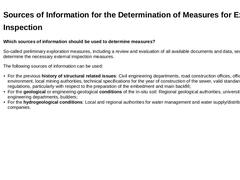
|
Which sources of information should be used to determine measures? So-called preliminary exploration measures, including a review and evaluation of all available documents and data, serve to determine the necessary external inspection measures. The following sources of information can be used: -
For the previous history of structural related issues: Civil engineering departments, road construction offices, offices for the environment, local mining authorities, …
|

|
For a first estimation of the feasibility and to determine a succeeding direct inspection program, the above-ground walkover inspection of the pipe run inclusive of a visual inspection of the street- or ground surface of the respective section of sewer in the catchment area is obligatory. In the process, possible effects of damage in sewer systems or drain systems (e.g. in the area of the manholes, inspection chambers, catch basins and street surface) … |

|
(Image: Picto Liste) What should be observed during inspection? The following aspects are important with respect to the site inspection [WPCFFD6]: Situation in the area of manholes -
Is the manhole top visible or could it have been covered during street work?
-
What is the condition of the top and manhole taper?
-
Does the level of the manhole top lie above or below the street level (indicating settling of either the manhole or the street)?
-
Are there any …
|
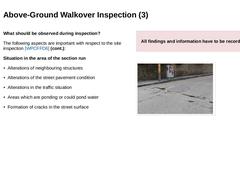
|
What should be observed during inspection? The following aspects are important with respect to the site inspection [WPCFFD6] (cont.): Situation in the area of the section run -
Alterations of neighbouring structures
-
Alterations of the street pavement condition
-
Alterations in the traffic situation
-
Areas which are ponding or could pond water
-
Formation of cracks in the street surface
All findings and information have to be recorded. (Image: Cracking … |

|
|
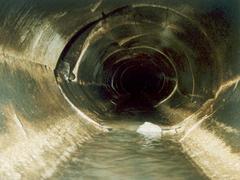
|
This module provides an introduction to the first of the four basic activities within the framework of integral urban drainage management according to EN 752, the INVESTIGATION. It is intended to cover all performance aspects of the drain and sewer system to the appropriate extent in order to provide the basis for the subsequent assessment of their performance. Therefore, this module provides an overview of the required investigation steps, collection and review of relevant information, and procedures for investigating the structural and operational condition of drain and sewer systems. After completing this lesson, you will have knowledge regarding: - The purpose of an investigation;
- The necessary investigation steps and required relevant information; and
- Procedures for investigating the structural and operational condition of drainage systems.
|
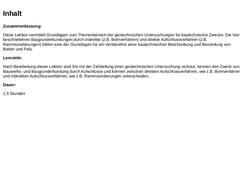
|
Summary: This module teaches the basics of geotechnical investigations for civil engineering purposes. The described subsoil investigation by indirect (e.g., drilling methods) and direct exploration methods (e.g., dynamic sounding) form the basis for an understanding of a civil engineering description and evaluation of soil and rock. Objectives: After completing this module, you will have a sound knowledge of: -
The objective of a geotechnical investigation;
|
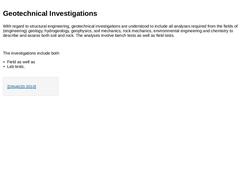
|
With regard to structural engineering, geotechnical investigations are understood to include all analyses required from the fields of (engineering) geology, hydrogeology, geophysics, soil mechanics, rock mechanics, environmental engineering and chemistry to describe and assess both soil and rock. The analyses involve bench tests as well as field tests. The investigations include both -
Field as well as
-
Lab tests.
|

|
What is the aim of a geotechnical investigation? The aim of a geotechnical investigation is to develop an idealized spatial subsoil model for the area of the pipeline zone and the adjacent in-situ soil. This model has to be as precise as possible, plausible and verifiable, as it serves as a basis for the planning and implementation of the rehabilitation measures. Important: Explorations in soil and rock provide only random samples. This means that … |

|
There is a variety of different investigation and analysis methods available that can be used to provide the required reliable and comprehensive data on the geotechnical parameters of the in-situ soil: (Image: Exploration and investigation methods within the framework of geotechnical investigation) (Image: Geotechnical investigations) (Image: Investigation … |